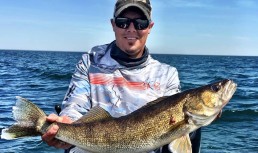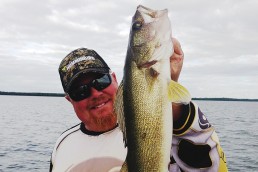Corral Tough-bite Summer Walleyes by Slippin’ ‘Em
SHARE THIS POST
Leech Lake can be a tough bite come July during the dog days of summer. As a guide, I am all about making sure I am flexible and adaptable to the moods of the fish for each day. I have spent countless hours on the water and I know I can’t force-feed the fish—believe me, I have tried. However, while being a die-hard rigging guy, I have adapted techniques when times have gotten tough.
One such approach has been using slip bobbers. While traditionally thought of as an evening deal, I have used it on many dog days to put stubborn walleyes in the boat. When fish get fickle, sometimes slippin’, or as we call it, “corkin’,” is the best approach.
A basic setup for slip-bobber fishing is a 7-foot, medium-action rod and a reel spooled with 10-pound-test PowerPro line. I like the braided line for better castability and hook-up rates. When using braid, all you need to do is keep the rod tip and starting reeling—no real hook-set is needed. Use a small or medium float that’s just big and bright enough to keep tabs on the bouncing summer waves. Ideally, you want that bobber sitting halfway up or three-quarters of the way into the water—depending on the wind and waves—so that when the fish takes the bait, there is little or no resistance.
Underneath the float there are a couple modifications that work. Use a swivel to attach a 3-foot section of fluorocarbon line and attach your hook or jig. When it is wavy, I use a smaller jig head at 1/8 ounce or 1/4 ounce to help keep it more vertical so it doesn’t bounce all over the waves. When hooking those leeches on a windy day, hook the jig or go right behind the sucker. If it is bright and calm, I tie on a number 6 plain hook, place a split shot 1 foot above the bait, cast it out and let it wander. Medium- to large-sized lively leeches over a shallow rock or sand structure will fool any roaming walleye to take a risk at a quick meal.
Areas to key in on Leech include wind-blown points, rocks and weeds. When it’s windy, I tend to utilize points with rocks. Ottertail, Battle and Stony all hold good areas to slip-bobber. On bright, calm days, I go in search of cabbage. As muskie guys will attest, Leech has great cabbage from Portage Bay to Steamboat Bay. This cabbage is scattered, thus I will be active while fishing. I will use my Lowrance to find the cabbage (down-imaging is used) and then use the anchor feature on my Minn Kota and make a few casts. If I don’t get bit, I will move on to the next clump of cabbage, repeating the process. It might take a few tries and I might only pick off one or two, but that is better than none.
Are you enjoying this post?
You can be among the first to get the latest info on where to go, what to use and how to use it!
Be sure to pay attention to your depth carefully. When setting your slip bobber, utilize your electronics to determine the depth where you will be casting. Allow enough room between the jig and the bottom to let the bait work hypnotically as it drifts across a rock pile, a point or among the cabbage.
It’s Minnesota—you’re a walleye fisherman so you better be familiar with the “holy trinity” of tactics to catch ’em here. That includes live-bait rigging, jigging and slip-bobbering. A lot of “walleye guys” like to rig or jig, but few confess a liking to using a slip bobber. The great thing about slip-bobber fishing is it can be used as a serious tournament presentation or is just a great way to socialize and relax with friends and the kids. After all, the kid in each of us still loves to watch a bobber disappear below the water. However, when the bite gets tough and our white-tipped foes are turning their noses up at the rigs and jigs, slip bobbers will help you get a grip on putting more of these ‘eyes in the boat.
Jim Ernster is a guide and pro staffer with Leisure Outdoor Adventures, a premier fishing guide service in Walker, Minn. Check them out at leisureoutdooradventures.com, or call 855-562-4665.
MWO
SHARE THIS POST
Did you enjoy this post?
You can be among the first to get the latest info on where to go, what to use and how to use it!
Jim Ernster
Jim Ernster is a guide and pro staffer with Leisure Outdoor Adventures, a premier fishing guide service in Walker, Minn. Check them out at leisureoutdooradventures.com or call 855-562-4665.



